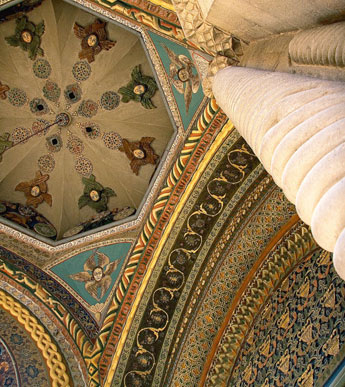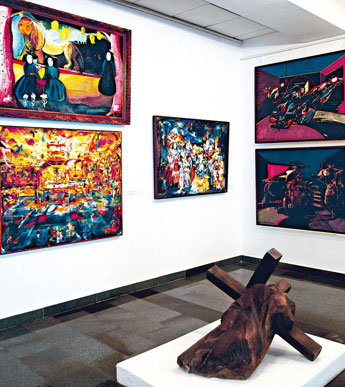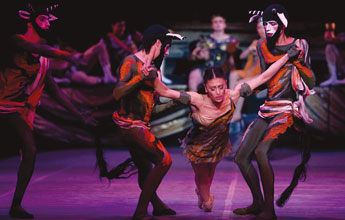Culture and Holidays
 Armenia’s cultural traditions are extraordinarily rich and diverse. In fact the country is often called an “open air museum” owing to more than 4,000 historical monuments representing various periods of the country’s history throughout the countrywide. Some of the best-known include:
Armenia’s cultural traditions are extraordinarily rich and diverse. In fact the country is often called an “open air museum” owing to more than 4,000 historical monuments representing various periods of the country’s history throughout the countrywide. Some of the best-known include:
- the cathedral and churches of Echmiatsin (IV-V century) and the archaeological site of Zvartnots (VII century);
- the monasteries of Haghpat and Sanahin (X-XIII century); and
- the monastery of Geghard and the Upper Azat Valley (IV century).
Since Armenia is one of the oldest countries in the world, it is not surprising that some of the artifacts found here date back more than 5,000 years. One recent fnd is a 5,500- year-old leather shoe, which is now displayed at the History Museum of Armenia.Among the most important monuments of Hellenistic art in Armenia is Garni temple (frst century B.C.), which is unique as a wholly preserved monument of this type in the CIS.Armenians were the frst people to accept Christianity as a state religion in the year 301, and many wonderful and valuable architectural monuments were built as a result. Symbols of Christianity’s triumph – khachkars – are scattered all over Armenia, and are perfect pieces of sculptural art, emphasizing extraordinary stone working skills.The creation of the Armenian alphabet in the year 405 stimulated progress in all creative endeavors. Evidence of this is a collection of 14,000 manuscripts, fragments and miniatures, which are preserved in Yerevan's Matenadaran (Institute of Ancient Manuscripts).In Yerevan, Armenia’s capital, are more than 40 art museums and galleries. Armenian culture is on display at the State History Museum, the National Gallery, the Museum of Folk-Art of Armenia, the Wood Carving Museum, the Sergei Parajanov Museum, and a number of home-museums of famous Armenian painters, poets and composers. An impressive historical monument in Yerevan is the Erebuny fortress, whose rich history is explained in the museum near the fortress.In large part because of its colorful and deep history, Armenia has become a renowned tourist destination. In 2011, about 760,000 tourists visited the country.
fortress, whose rich history is explained in the museum near the fortress.In large part because of its colorful and deep history, Armenia has become a renowned tourist destination. In 2011, about 760,000 tourists visited the country.
ARMENIAN THEATER HAS A HISTORY DATING BACK MORE THAN 2,000 YEARS.
Armenia celebrates its rich cultural diversity with an annual calendar of events:
- An annual festival in July devoted to Armenian national cuisine and another in October to celebrate the national wine-feast.
- The summer “Golden Apricot” annual national cinema festival has become a traditional cultural event, bringing together local and foreign moviemakers.
- The High Fest International Performing Arts Festival, with participants from nearly 30 countries, usually takes place every year in early October. The Armenian theater has a history dating back more than 2,000 years. The largest drama theater in Armenia is the G. Sundukyan Theater in Yerevan. Plays are also performed at the Stanislavski State Russian Drama Theater, the State Theater of Musical Comedy, the National Academic Opera and Ballet Theater, the Chamber Theater. the Yerevan State Theater of the Young Spectator, and the State Puppet Theater for younger generations to enjoy art
- “One Nation, One Culture” is a biennial festival that is aimed at strengthening spiritual and cultural links among Armenians all over the world. Armenia also boasts rich musical traditions.
 Sayat Nova, Komitas, Aram Khachaturian and Armen Tigranyan are among Armenia's best-known musicians and composers in the world. Aram Khachaturian’s “Sabre Dance”, the ballet “Spartacus”, and Armen Tigranyan’s “Anush” opera all have been presented far beyond the borders of Armenia, and have been successfully preformed on international stages. Modern music in Armenia is mainly characterized by pop, rock and jazz. Rock and jazz music festivals in Yerevan have become annual traditions.All museums, theaters and cinemas are accessible at affordable prices.
Sayat Nova, Komitas, Aram Khachaturian and Armen Tigranyan are among Armenia's best-known musicians and composers in the world. Aram Khachaturian’s “Sabre Dance”, the ballet “Spartacus”, and Armen Tigranyan’s “Anush” opera all have been presented far beyond the borders of Armenia, and have been successfully preformed on international stages. Modern music in Armenia is mainly characterized by pop, rock and jazz. Rock and jazz music festivals in Yerevan have become annual traditions.All museums, theaters and cinemas are accessible at affordable prices.
|
Here is the list of Armenian national holidays and memorial days: |
|
|
December 31 - January 6 New Year and Christmas Holidays Day-off January 7 All Souls' Day January 28 National Army Day February 21 Armenian language Day February 28 Memorial Day for the Victims of Organized Massacres in Azerbaijan SSR and the Protection Day of the Rights of the Deported Armenian Population March 8 Women's Day Day-off April 7 Maternity and Beauty Day April 24 Memorial Day for Genocide Victims Day-off May 1 Labor Day Day-off May 8 Yerkrapah's Day (War-Volunteers' Day) May 9 Victory and Peace Day Day-off May 15 Family Day |
May 28 Republic Day Day-off June 1 Children's Rights Protection Day June 14 Memorial Day of Victims of Political Repressions July 5 Constitution Day Day-off September 1 Knowledge day September 21 Independence Day Day-off October 5 Teachers’ Day 2nd Saturday of October Tarkmanchats Day (Translators' Day) November 10 Day of Local Government December 7 Memorial Day for Earthquake Victims 8 weeks before Easter Day, on Thursday St. Vardanants Day (Good Deeds Day) 64 days after Easter Day, on Sunday Holy Echmiadzin Day |
































 Culture and holidays
Culture and holidays